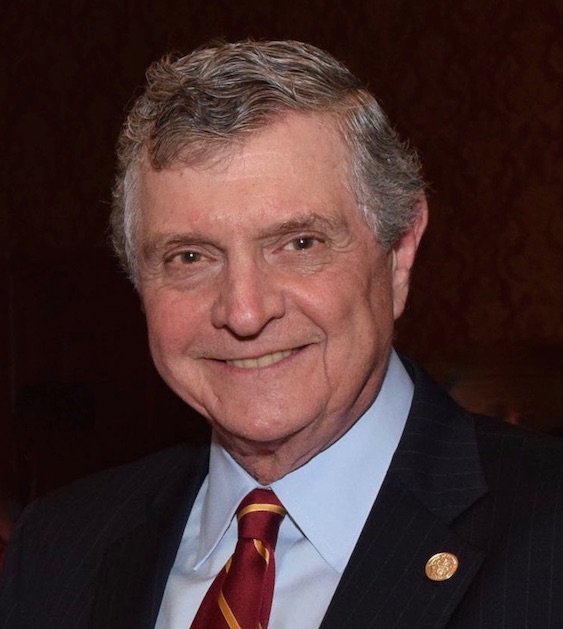Letter from Village Mayor Jon Mark
- Details
- Written by: Joanne Wallenstein
- Hits: 6323
 To the Editor: The Village experienced a record level of participation in yesterday's election. I wish to thank the Village staff, particularly Village Clerk Donna Conkling and Police Chief Andrew Matturo and their staffs, for the efficient and professional manner with which they handled the voting logistics and process. They served with grace under pressure and provided a very public demonstration of the hard work the Village staff puts in every day in serving the residents of Scarsdale. For that they have our gratitude and thanks.
To the Editor: The Village experienced a record level of participation in yesterday's election. I wish to thank the Village staff, particularly Village Clerk Donna Conkling and Police Chief Andrew Matturo and their staffs, for the efficient and professional manner with which they handled the voting logistics and process. They served with grace under pressure and provided a very public demonstration of the hard work the Village staff puts in every day in serving the residents of Scarsdale. For that they have our gratitude and thanks.
I also want to thank all the residents who participated in the campaigns and who came out to vote. The extraordinary turnout was heartening. While governing decisions may not always please all residents, the decision making process is well served when many points of view are expressed in a thoughtful manner and when residents participate in the process. As I conclude my term, it is my hope that residents remain interested in our local government and understand the importance of volunteering to serve. That is what makes Scarsdale work and maintains our shared sense of community.
It has been an honor and a privilege to be of service to the community in which I grew up and wish all residents the best for the years ahead.
Jon Mark, Mayor
Note: We welcome your comments. Please include your real first and last names.
The Sky Isn't Falling in Scarsdale: Rhetoric and Reality
- Details
- Written by: Joanne Wallenstein
- Hits: 7689
 This is the opinion of site founder Joanne Wallenstein: For years, Robert Berg, candidate for Mayor of Scarsdale has been warning that the sky will fall over Scarsdale. Just this week, at the Candidate's Forum of the League of Women Voters of Scarsdale, he called the Village "a disaster" that could go into a "death spiral" if spending was not contained. He said the condition of Scarsdale's 79 miles of roads was "atrocious" and called for them all to be replaced. At the same time he raised fears that rising taxes would chase empty nesters out of town, causing more families with young children to move in and strain the resources of the school system.
This is the opinion of site founder Joanne Wallenstein: For years, Robert Berg, candidate for Mayor of Scarsdale has been warning that the sky will fall over Scarsdale. Just this week, at the Candidate's Forum of the League of Women Voters of Scarsdale, he called the Village "a disaster" that could go into a "death spiral" if spending was not contained. He said the condition of Scarsdale's 79 miles of roads was "atrocious" and called for them all to be replaced. At the same time he raised fears that rising taxes would chase empty nesters out of town, causing more families with young children to move in and strain the resources of the school system.
Why did this all sound so familiar?
I looked back at earlier reports and found this letter that Bob wrote to Scarsdale10583 when he crusaded to organize the first NO vote on a Scarsdale School budget in 43 years in 2013. Again he appealed to older residents saying, "Stop the spending madness and stop it NOW! .... Empty nesters, in particular, should ask themselves: How long will I be able to afford to stay in my home in Scarsdale where I have lived for 20, 30, 40 years or more if my property taxes keep soaring? Unless we are fortunate enough to be multi-millionaires, sadly, for most of us, we will come to the only rational economic decision – we'll have to move away because of the excessive property tax burden, which is predominantly driven by the school budget. Forcing our empty nesters to leave town because of uncontrolled school spending is wrong on so many levels and is destructive to the very fabric of the community and to the many community organizations that depend heavily on the extraordinary time and talents provided by empty nesters. Scarsdale is not just a way station for people to leave after they have had their children educated in our schools – an education which empty nesters subsidize by more than half. Empty nesters – this is your community – you need to come out and vote "NO" and protect your financial ability to remain here."
Berg was successful in defeating the budget, and as a consequence, pressuring Scarsdale School Superintendent Michael McGill to retire a year earlier than planned.
Following the 2016 revaluation, Berg was equally as pessimistic. In the September 23, 2016 issue of the Scarsdale Inquirer, he said, "The system is not working. It's a disaster here."
And on Scarsdale10583 he repeatedly called the Ryan a "train wreck waiting to happen." He continued, "The Ryan reval mess is just not "unanticipated consequences of well-intentioned actions." These consequences were forewarned by me and others. We are not Chicken Little, and yes, the sky did fall."
So is Scarsdale a disaster?
That issue was debated at the candidate's forum on Tuesday night March 7 when several sitting Village Trustees presented facts to demonstrate that the Village is by all measures fiscally sound and well managed.
Trustee Matt Callaghan said that Moody's has given the Village of Scarsdale a AAA bond rating citing healthy reserves, low debt and a wealthy tax base. Trustee Carl Finger told the group that Con Edison would now pay to repair all roads that they tear up repairing or replacing equipment and that an audit of Optimum's contract with the Village yielded an additional $100,000 in revenue.
At Village Hall, Mayor Jon Mark disputed the claim that all of the roads need to be replaced, saying, "Note also that most of our roads are not in horrible condition. Sweeping statements that imply all 79 miles of Village roads are presently in need of re-paving tend to overstate the problem."
The most recent demographers reports of the population of the Scarsdale schools show no evidence that an exodus of empty nesters had caused the school population to exceed school capacity. In fact, for the past ten years enrollment has been relatively flat and is projected to remain at current levels for the foreseeable future.
Has the 2016 revaluation caused a train wreck? An analysis of home sales in 2016 shows that Ryan's assessments for the 2016 tax roll are equally if not closer to market value than the assessment roll from 2015.
Recent tax increases do not appear to be climbing to unsustainable levels. The latest projections from both the school and the village are quite reasonable. According to Village Manager Steve Pappalardo, Village taxes which represent about 18% of your local tax bill, are projected to go up or 2.19% or about $223 per year for a home valued at $1.5mm. The school administration is estimating a 1.4% budget-to-budget increase for the 2017-18 school year, even in the midst of a substantial capital improvement project.
Is the sky falling as Berg warns?
By all measures, the answer is no.
In fact, the only crisis that I see in town is the one caused by the use of exaggeration and hyperbole by Berg's new party to unseat the candidates chosen by the Citizens' Nominating Committee. If the Voters' Choice Party succeeds, I fear that Scarsdale will become as polarized as the rest of the country and nasty partisan politics will prevail here as they do elsewhere. Investigations, FOIL requests, attacks on volunteers and village managers and lawsuits will discourage good people from serving on Village boards and working in Village Hall.
The real risk is that we will lose our tradition of building consensus through careful consideration of the facts and civil discussion ... and that might be the disaster for all who value our unique form of governance and the special place we live.
Peter Tailor and Indigo Chic Are Gone
- Details
- Written by: Joanne Wallenstein
- Hits: 6818
 More comings and goings among retailers in Scarsdale and Hartsdale: A friend reported that she climbed the stairs in the Wilgren Building above Metro Deli to ask Lena of Peter Tailoring to do an alteration. Lena was a favorite in the community and often helped entire families get their clothing adjusted for big occasions. My friend got to the door of the shop only to find that Lena and the scores of dresses and her wonderful bulletin board of bat mitzvah and wedding photos were gone. The jumble of seamstresses, mannequins and shoes had been totally cleaned out.
More comings and goings among retailers in Scarsdale and Hartsdale: A friend reported that she climbed the stairs in the Wilgren Building above Metro Deli to ask Lena of Peter Tailoring to do an alteration. Lena was a favorite in the community and often helped entire families get their clothing adjusted for big occasions. My friend got to the door of the shop only to find that Lena and the scores of dresses and her wonderful bulletin board of bat mitzvah and wedding photos were gone. The jumble of seamstresses, mannequins and shoes had been totally cleaned out.
A sign on the door indicated that someone named Top Tailor was now in business at the site – and the new tailor had apparently purchased the business.
We contacted Rush Wilson who owns the building to find out what happened to Lena. Rush said, "After many years of excellent service, Lena decided to retire. I spoke to her last week and she had just returned from a couple of weeks in Italy. She sounds good and rested. She sold the business to an excellent tailor and I hope everyone will give him a try."
Indigo Chic
Sadly Indigo Chic in Hartsdale is also gone. The store had great fashions for women. Perhaps they didn't get enough foot traffic or shoppers were discouraged by the lack of parking? Indigo Chic also has a location in the Rye Ridge Shopping Center – so if you're looking for them – take a drive.
Village Considers Hiring Consultants to Conduct an Organizational Evaluation of the Assessor's Office
- Details
- Written by: Joanne Wallenstein
- Hits: 7819
 In an effort to restore public trust in the Scarsdale Village Assessor's Office after the controversial 2016 revaluation, Village Managers are proposing to retain a professional consulting company to do an organization assessment of the office. The consultants would study the current workings of the office, analyze processes, research best practices in other municipalities and make recommendations to improve their effectiveness and efficiency.
In an effort to restore public trust in the Scarsdale Village Assessor's Office after the controversial 2016 revaluation, Village Managers are proposing to retain a professional consulting company to do an organization assessment of the office. The consultants would study the current workings of the office, analyze processes, research best practices in other municipalities and make recommendations to improve their effectiveness and efficiency.
Looking toward the next revaluation the consultants would investigate technologies and methodologies to give the Village a roadmap toward selecting a vendor to conduct future revaluations. Village Manager Steve Pappalardo maintained that bringing in an outside firm to conduct the evaluation would help build community confidence in the results.
Pappalardo said that the Village had contacted four potential firms, met with three and received proposals from two. After evaluating both proposals Pappalardo recommended that the Village retain Management Partners from Cincinnati, Ohio at a cost of $34,990 for 179 hours of work. Management Partners also brought in a subcontractor, John Burin, who has expertise in assessments to assist with the job.
On Tuesday night 2-28 the Trustees invited Kevin Knutson from Management Partners and John Burin to make a presentation and answer questions. Knutson said he was a former Village Manager of Coral Gables Florida who now works at Management Partners, an 80-person firm with over 700 clients in 41 states.
He introduced John Burin who is a former city manager in Elmira, an assessor and the former owner of an appraisal company. He said his role would be to "eliminate the controversy over the revaluation," and to "Come up with recommendations on how we can do things more efficiently and transparently." The consultants would interview communities that have been successful with keeping assessments up to date and determine what software and methodologies they use to maintain valuations at market rate.
Both the Trustees and residents in attendance questioned the consultants intensively. Trustee Marc Samwick wanted to know if the outcome of the project would be specific recommendations on whether the Village should conduct another revaluation or set up a continuous process to update valuations. Deb Pekarek wanted to know if the consultants would investigate potential revaluation vendors and provide costs. Matt Callaghan asked if the consultants would provide a timeline of deliverables.
Burin came under particular scrutiny because some said that Elmira real estate was in no way similar to that of Scarsdale. He said, "We didn't have the values you have in Scarsdale in Elmira, but we did have big shifts in commercial vs. residential values. It was very controversial. Assessment offices in New York are all governed by the New York State Office of Real Property and everyone is dealing with the same thing."
Audience members questioned Burin about his experience and found that he conducted revaluations in the 1990's and was not familiar with the software that is now used but Burin said that Management Partners would provide technological expertise.
Others asked if the consultants would meet with the public to get their views on the issues.
Though the consultant's task was to analyze the organization and the processes, Robert Berg questioned the assignment saying, "We all know what the problems are." Trustee Bill Stern responded and said, "I take exception to Bob's statement that everyone knows what the problem is – everyone does not agree – there are issues that need to be dissected. Anyone who comes in with bias is not doing a service."
Berg asked, "How can we be confident if you're not familiar with the models?"
Michael Levine said, "You both mentioned efficiency. It's not an issue of efficiency and not an issue of building permits or exemptions. If you think those are the issues you're not up to speed. The issues are supervision. Problems in the department were not elevated to the Village Managers and the Board. There are issues with public trust and acceptance. How did we get to this credibility issue? That's why I think you are here."
Steve Pappalardo assured Levine that "The firm is fully aware of what happened. They are going to do an overall management study of that office. They are not going to come out with a recommendation on building the proper model. But we are going to come out with a plan to hire a new firm to do a revaluation."
The Trustees said they would mull over the meeting and come up with a recommendation after subsequent discussion.
Village Seeks Dismissal of Article 78 Lawsuit
- Details
- Written by: Joanne Wallenstein
- Hits: 9494
 Attorneys representing the Village of Scarsdale, Terry Rice and Dan Vinclette filed a motion to dismiss the Article 78 brought by the Scarsdale Committee for Fair Assessments on January 13, 2017. Drafted by Scarsdale Attorney Robert Bernstein and verified by Mayra Kirkendall-Rodriguez for 151 petitioners, the Article 78 asked the court to annul, void and rescind the 2016 tax assessment roll for Scarsdale and roll back valuations to 2015 assessments. If the Village failed to roll back the assessments, they asked that the petitioners who would pay more taxes on the 2016 roll than the 2015 roll be refunded the difference.
Attorneys representing the Village of Scarsdale, Terry Rice and Dan Vinclette filed a motion to dismiss the Article 78 brought by the Scarsdale Committee for Fair Assessments on January 13, 2017. Drafted by Scarsdale Attorney Robert Bernstein and verified by Mayra Kirkendall-Rodriguez for 151 petitioners, the Article 78 asked the court to annul, void and rescind the 2016 tax assessment roll for Scarsdale and roll back valuations to 2015 assessments. If the Village failed to roll back the assessments, they asked that the petitioners who would pay more taxes on the 2016 roll than the 2015 roll be refunded the difference.
The Village of Scarsdale countered by asking for the dismissal of the Article 78 based on a number of procedural issues and the petitioners' failure to "allege any cognizable cause of action."
In an affirmation of support of the memorandum to dismiss the case, the attorneys write, "The petition consists of nothing more than a host of unsubstantiated allegations that are designed to disparage the name and reputation of the public officials involved in the 2016 revaluation.... Moreover, Petitioner ignores the fact that property valuations made by tax assessors are presumptively valid and that the presumption can only be rebutted with substantial evidence of overvaluation through proof based upon both sound proof and objective data. Here, Petitioner failed to present any evidence to rebut this presumption."
Recounting the history of the revaluation, the affirmation of support explains the role of Scarsdale resident Mayra Kirkendall Rodriguez who has been a vocal opponent of the Village Board and organized the petitioners to file the Article 78. The affirmation says that after the Village filed the 2016 roll, "Mayra Kirkendall Rodriguez became an immediate critic of the results and the valuation process. Despite having been told repeatedly that the Assessor is independent and that elected officials did not have the authority to supersede the Assessor's determination to file the final 2016 assessment roll, Mayra Kirkendall Rodriguez continued to insist that the Town/Village Board engage in such unlawful conduct.... When she realized that the Board would not supersede the independent determination of the Assessor, she then insisted that the Board seek special legislation from the State Legislature and Governor to invalidate the revaluation. When the Board declined to pursue that political remedy she threatened the Board with litigation and subsequently facilitated the commencement of this action. It should be noted that Mayra Kirkendall Rodriguez exercised her rights under Article 5 of the Real Property Tax Law and received a reduction in her 2016 assessment, almost to the level of her 2015 assessment."
The Village also explains why a roll back to a prior tax roll would not be legal or feasible for the Village as it would "deprive certain property owners of their right to grieve their 2015 assessment because certain statutory deadlines have passed."
In a 44-page memorandum filed on February 15 they argue for dismissal because:
1) The suit failed to name of the County of Westchester and the Scarsdale School District who they call "indispensable parties" who receive taxes based on the assessment roll. Since they would be required to pay refunds and could be "adversely affected" the lawyers argue that the suit can't proceed in their absence.
2) The suit fails to provide a factual basis for "outlandish claims" related to the revaluation and did not provide "substantial evidence of overvaluation based on sound theory and objective data."
3) The Committee for Fair Assessments lacks standing to assert a claim as it is an unincorporated association who does not own property or pay taxes in the Village. The memorandum says that the claim does not demonstrate injury to any "members" of the committee and failed to establish that it is advocating a position fairly representative of the community of interests which it seeks to protect. It doesn't provide the specifics of how individual members were affected and does not establish whether or not the organization was open to all individuals who were affected.
4) The claim does not provide facts to support that the 2016 revaluation "constituted a waste of or injury to public funds" or that it was illegal, imperiled the public interest or "calculated to work public injury.
The Village contends that the claim that the group was denied equal protection is baseless for several reasons ... one because the petition fails to show how the petitioners were treated differently than "similar persons or entities." The motion says, since the group was an ad hoc organization it would be difficult to comprehend how any equal comparator could exist. It says, "The petition challenges broad methodologies of assessment but fails to provide a single instance of purportedly similarly situated person or property that was treated differently."
The memorandum cites extensive case law to show that rescinding a municipality's tax roll has not previously been supported in a court of law. In Hellerstein vs. Assessor of Town of Islip in 1975, the court said, "if we invalidate the assessment roll this could bring fiscal chaos to the Town of Islip. ... and cause disorder and confusion in public affairs." Mayor Jon Mark cited this same case repeatedly over the last year and a half when residents pleaded with the Village Board to throw out the 2016 assessment roll.
Under General Municipal Law 51 the plaintiff was required to furnish a bond to the defendant therein, to be approved by a justice of the Supreme Court. The memorandum notes that the petitioners failed to post a bond.
Several people who signed the Article 78 and paid $500 each to fund the action are now running for Scarsdale Village Trustee. Brice Kirkendall-Rodriguez, husband of Mayra Kirkendall Rodriguez, who led the challenge to the Village, signed the petition. Candidate for Trustee Robert Selvaggio is a petitioner and Robert Berg, candidate for Village Mayor supported the suit saying he would have signed it except for the fact that his assessment was reduced between 2014 and 2016 and he therefore had nothing to gain. In recent weeks these candidates from the newly formed Scarsdale Voters' Choice Party who supported the suit then asked the Village to settle it rather than spend taxpayer funds to fight it. They said, "We will, with the Court's assistance, fashion a fair resolution of the lawsuit."
However, the Village launched a defense against the Article 78 which, if settled, would cost taxpayers considerable funds and might lead to further lawsuits. The outcome of the case may impact the results of the upcoming Village election on March 21.
About the Village's motion to dismiss, Robert Berg, who is currently running on the slate of the Scarsdale Voter's Choice Party for Mayor in opposition to the Scarsdale Citizens Party, said, "It reminds me of the alternative facts from Donald Trump. It sounds like the Ryan reval was fine and these people just disagree with the results. It ignores the entire history of what happened here. Mayor Mark admitted it was a mistake, no one on the Village Board was happy with it and the Village is withholding money from Ryan. These are all legal technicalities. If you read the substance of the brief, there's nothing there. The bottom line is that the reval is arbitrary and capricious and they should settle it. They are fighting this ... but to what end?"
The case has been assigned to Judge Scheinkman and it is not known when a decision will be announced.










